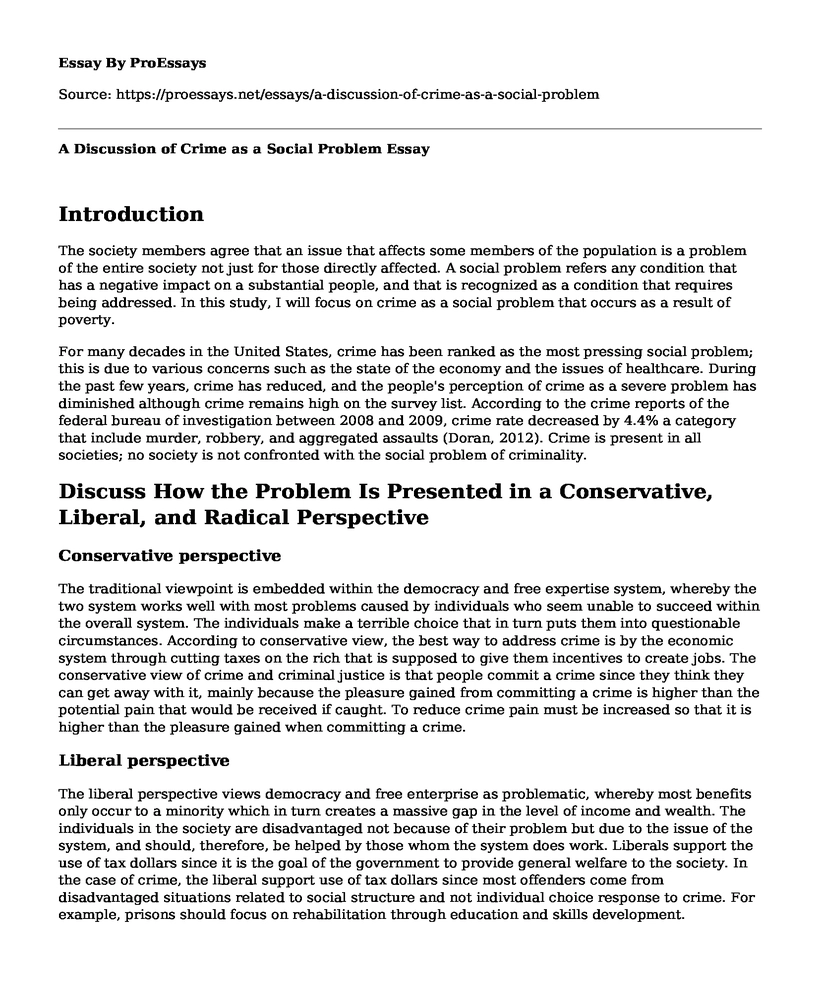Introduction
The society members agree that an issue that affects some members of the population is a problem of the entire society not just for those directly affected. A social problem refers any condition that has a negative impact on a substantial people, and that is recognized as a condition that requires being addressed. In this study, I will focus on crime as a social problem that occurs as a result of poverty.
For many decades in the United States, crime has been ranked as the most pressing social problem; this is due to various concerns such as the state of the economy and the issues of healthcare. During the past few years, crime has reduced, and the people's perception of crime as a severe problem has diminished although crime remains high on the survey list. According to the crime reports of the federal bureau of investigation between 2008 and 2009, crime rate decreased by 4.4% a category that include murder, robbery, and aggregated assaults (Doran, 2012). Crime is present in all societies; no society is not confronted with the social problem of criminality.
Discuss How the Problem Is Presented in a Conservative, Liberal, and Radical Perspective
Conservative perspective
The traditional viewpoint is embedded within the democracy and free expertise system, whereby the two system works well with most problems caused by individuals who seem unable to succeed within the overall system. The individuals make a terrible choice that in turn puts them into questionable circumstances. According to conservative view, the best way to address crime is by the economic system through cutting taxes on the rich that is supposed to give them incentives to create jobs. The conservative view of crime and criminal justice is that people commit a crime since they think they can get away with it, mainly because the pleasure gained from committing a crime is higher than the potential pain that would be received if caught. To reduce crime pain must be increased so that it is higher than the pleasure gained when committing a crime.
Liberal perspective
The liberal perspective views democracy and free enterprise as problematic, whereby most benefits only occur to a minority which in turn creates a massive gap in the level of income and wealth. The individuals in the society are disadvantaged not because of their problem but due to the issue of the system, and should, therefore, be helped by those whom the system does work. Liberals support the use of tax dollars since it is the goal of the government to provide general welfare to the society. In the case of crime, the liberal support use of tax dollars since most offenders come from disadvantaged situations related to social structure and not individual choice response to crime. For example, prisons should focus on rehabilitation through education and skills development.
Radical perspective
The radical view shows that crime originates from the value of capitalism, whereby the perspective begins when the idea that conflict between classes characterizes capitalist societies, for example, labor versus management, race and also gender. From the radical view, the government's role is not neutral but rather tries to support the capitalist system and those who benefit from it.
Crime Advocacy Response
Crime advocacy response can be conducted through several ways that include
Rehabilitation
The idea of rehabilitating offenders relies on the concept of social aberrations and the offender as the misfit whose unexpected behavior can be changed as per the society norms (Eitzen, 2013). Rehabilitation includes varying amounts of counseling, educational, and training programmes. The initiatives that have had tremendous success are those that prepare criminals to enter in the world of legitimate work and enable them to get jobs.
The prevention of crime
Crime prevention can be handled in three ways. This includes, first, dealing with conditions in the individual's environment that are believed to lead to crime such as creating employment and improved housing. Secondly, identify various services or programs that are designed to prevent further crime, for example, probations and training schools. Thirdly, identification of the total influences and activities that lead to the development of criminal activities, for example trying to reduce childhood exposure to illegal activities.
Social policy
In efforts to reduce crime, the government sets policies that work on the criminal justice. Such strategies include mandatory sentencing for those caught conducting illegal activities, increased penalties for those found in a crime, for example imposing huge fines or life imprisonment, and gun control policies; these policies are aimed at restricting access to guns and also licensing of gun holders.
References
Doran, B. J., & Burgess, M. B. (2012). Why Is Fear of Crime a Serious Social Problem?. In Putting Fear of Crime on the Map(pp. 9-23). Springer New York.
Eitzen, D. S., Zinn, M. B., & Smith, K. E. (2013). Social problems. Pearson Higher Ed.
Cite this page
A Discussion of Crime as a Social Problem. (2022, Apr 04). Retrieved from https://proessays.net/essays/a-discussion-of-crime-as-a-social-problem
If you are the original author of this essay and no longer wish to have it published on the ProEssays website, please click below to request its removal:
- Big Intelligence
- The Historical Development of the Civil Rights Movement Essay
- Essay Sample on Current Crime in South Africa
- Research Paper on Media Influences on Aggression
- Essay on Crash: Racial Injustices, Socioeconomic Status, and Human Interaction
- Research Paper on Department of Homeland Security: Securing Borders, Enhancing Security
- Paper Example on Social Hierarchies and Their Impact







